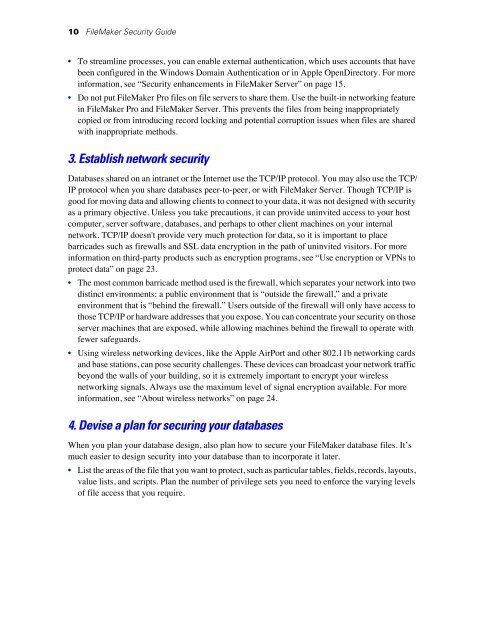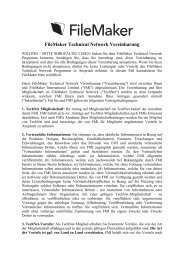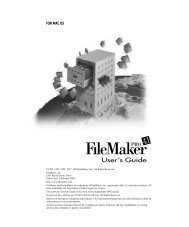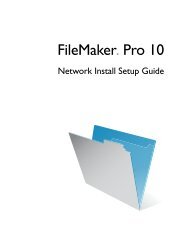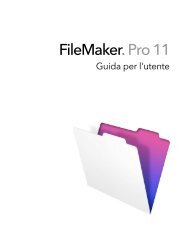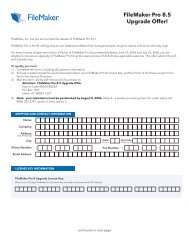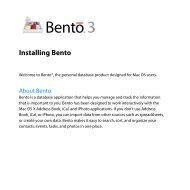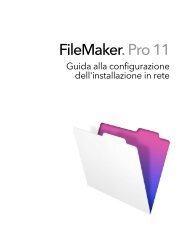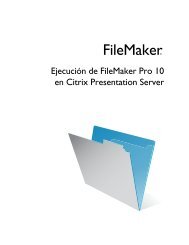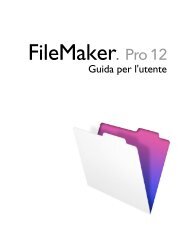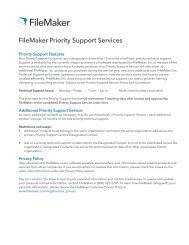FileMaker Security Guide
FileMaker Security Guide
FileMaker Security Guide
You also want an ePaper? Increase the reach of your titles
YUMPU automatically turns print PDFs into web optimized ePapers that Google loves.
10 <strong>FileMaker</strong> <strong>Security</strong> <strong>Guide</strong><br />
• To streamline processes, you can enable external authentication, which uses accounts that have<br />
been configured in the Windows Domain Authentication or in Apple OpenDirectory. For more<br />
information, see “<strong>Security</strong> enhancements in <strong>FileMaker</strong> Server” on page 15.<br />
• Do not put <strong>FileMaker</strong> Pro files on file servers to share them. Use the built-in networking feature<br />
in <strong>FileMaker</strong> Pro and <strong>FileMaker</strong> Server. This prevents the files from being inappropriately<br />
copied or from introducing record locking and potential corruption issues when files are shared<br />
with inappropriate methods.<br />
3. Establish network security<br />
Databases shared on an intranet or the Internet use the TCP/IP protocol. You may also use the TCP/<br />
IP protocol when you share databases peer-to-peer, or with <strong>FileMaker</strong> Server. Though TCP/IP is<br />
good for moving data and allowing clients to connect to your data, it was not designed with security<br />
as a primary objective. Unless you take precautions, it can provide uninvited access to your host<br />
computer, server software, databases, and perhaps to other client machines on your internal<br />
network. TCP/IP doesn't provide very much protection for data, so it is important to place<br />
barricades such as firewalls and SSL data encryption in the path of uninvited visitors. For more<br />
information on third-party products such as encryption programs, see “Use encryption or VPNs to<br />
protect data” on page 23.<br />
• The most common barricade method used is the firewall, which separates your network into two<br />
distinct environments: a public environment that is “outside the firewall,” and a private<br />
environment that is “behind the firewall.” Users outside of the firewall will only have access to<br />
those TCP/IP or hardware addresses that you expose. You can concentrate your security on those<br />
server machines that are exposed, while allowing machines behind the firewall to operate with<br />
fewer safeguards.<br />
• Using wireless networking devices, like the Apple AirPort and other 802.11b networking cards<br />
and base stations, can pose security challenges. These devices can broadcast your network traffic<br />
beyond the walls of your building, so it is extremely important to encrypt your wireless<br />
networking signals. Always use the maximum level of signal encryption available. For more<br />
information, see “About wireless networks” on page 24.<br />
4. Devise a plan for securing your databases<br />
When you plan your database design, also plan how to secure your <strong>FileMaker</strong> database files. It’s<br />
much easier to design security into your database than to incorporate it later.<br />
• List the areas of the file that you want to protect, such as particular tables, fields, records, layouts,<br />
value lists, and scripts. Plan the number of privilege sets you need to enforce the varying levels<br />
of file access that you require.


